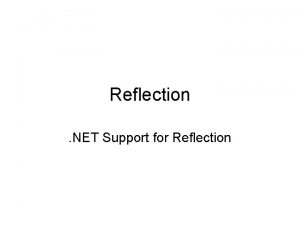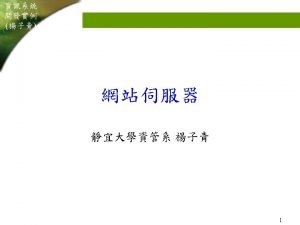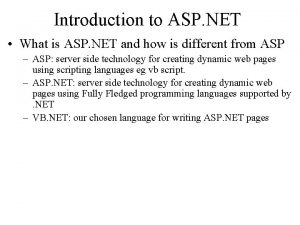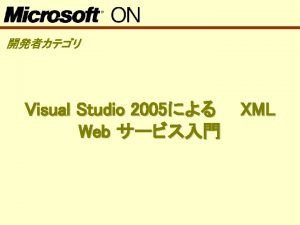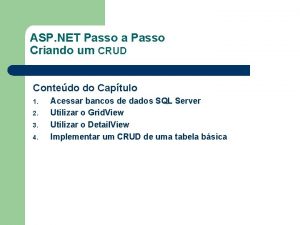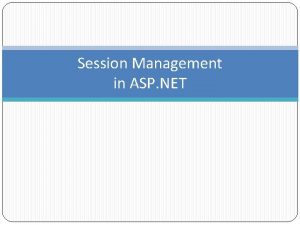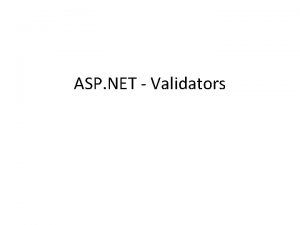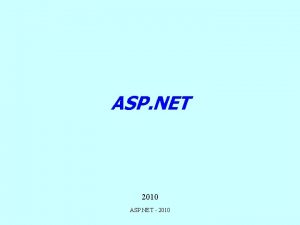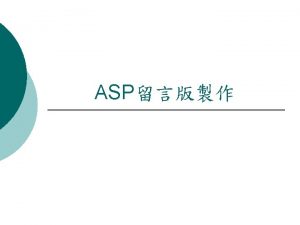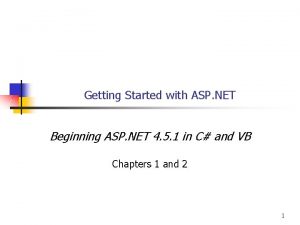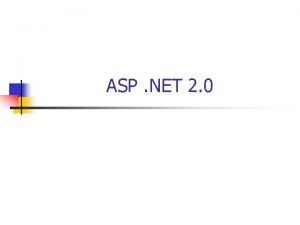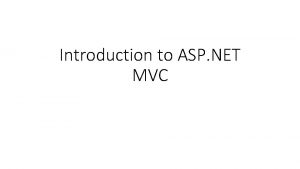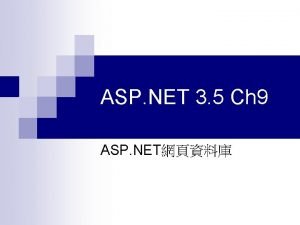ASP NET Caching Pradeepa Chandramohan What is Caching


















- Slides: 18

ASP. NET Caching - Pradeepa Chandramohan

What is Caching? • • • Storing data in memory for quick access. In Web Application environment, data that is cached is usually, commonly displayed database values. Repeated database calls are avoided. Demand on Web server’s and database server’s system resources are decreased. Increases performance by keeping frequently accessed data in memory.

Types of Caching • • Output Caching Fragment Caching Data Caching Time based Caching

Output Caching • • Also known as Page level Caching. Implementation is through an Output Cache Engine. Each time an ASP. NET page request comes in, the engine checks for a cached output entry. If found, this cached HTML is sent as response, otherwise, the page is dynamically created and stored in the Output Cache Engine. Useful in cases of many static pages.

Output Caching Implementation • • By using the Output. Cache page directive. Syntax is as shown below: <%@Output. Cache Duration=“ 60” Vary. By. Param=“none”%> • • Duration – number of seconds the HTML output of the Web page is held in Cache. Vary. By. Param – Specifies how the caching should be performed based on the query string supplied to the page.

Output Caching - Example • Consider the following URL: http: //localhost/Caching/Web. Form 1. aspx? name=John&newsid=12 • Query String passed to the page is name=John&newsid=12 • Changing the Vary. By. Param attribute: <%@ Output. Cache Duration=“ 15” Vary. By. Param=“Name” %> • • Page will be cached according to the Name key. Consider the following two URLs http: //localhost/Caching/Web. Form 1. aspx? name=John&newsid=12 http: //localhost/Caching/Web. Form 1. aspx? name=John&newsid=45 • Second page will be from cache (Cache will be refreshed only if the Name value changes)

Output Caching – Example (Contd. . ) • Consider the following two URLs: http: //localhost/Caching/Web. Form 1. aspx? name=John&newsid=12 http: //localhost/Caching/Web. Form 1. aspx? name=John&newsid=45 • For the page to be regenerated, Name and News. ID keys have to be changed. <% Output Cache Duration=“ 15” Vary. By. Param=“Name; News. ID” %> • • This causes the second page to be refreshed. Equivalent to using a *, which means change in any key would regenerate the page. <% Output Cache Duration=“ 15” Vary. By. Param=“*” %> • If the page has to be cached regardless of query string ‘none’ can be used. <% Output Cache Duration=“ 15” Vary. By. Param=“none” %>

Fragment Caching • • Caches regions of the page content. More powerful than Output Caching. This technique separates portions of a page that takes more time to create (such as database queries) from other parts of the page. The part of the page that requires less system resources can be generated dynamically for each request.

Fragment Caching - Example • • Consider a Web Application that displays the news titles in a Combo Box. The dataset containing the news is cached in order to minimize the number of times the application wants to connect to the SQL server to retrieve the news.

Fragment Caching – Example (Contd. . ) • • First time the page loads, user clicks on the Get News button to get the news from the SQL Server. We assume that the news changes daily. Page is refreshed each time the date changes. The cached version is displayed to all the users visiting the page on the same day.

Data Caching • • • Storing data in memory for quick access. Items in the data cache will be evicted from memory, if memory becomes scarce. While adding items to a data cache, the duration of how long it can persist can be specified.

Data Caching - Implementation • • . NET data caching API is comprised of two classes in the System. Web. Caching namespace. The first class (Cache) is used to add and remove items from the data cache. The second class (Cache dependency) is used to assign a cache dependency to an item in the data cache. To add an item: Cache[“key”] = value; • • This adds the item value to the data cache with the key. Key is used to reference the item at some later point.

Data Caching – Implementation (Contd. . ) • To extract the value inserted above: value = Cache. Get(“Key”) • To remove item from the cache: Cache. Remove(“Key”)

Time based Caching • • Caching based on time i. e. the data is available only for a certain period of time. Two ways to use: - Absolute Expiration - Sliding Expiration Absolute Expiration – Cache is set to expire on a particular date and time. Sliding Expiration – Cache is set to expire after certain period of inactivity.

Time based Caching - Implementation • Absolute Expiration Cache. Insert(“News”, ds, null, Date. Time. Now. Add. Minutes(2), Cache. No. Slid ing. Expiration) • The cache is set to expire exactly two minutes after the user has retrieved the data. • Sliding Expiration Cache. Insert(“News”, ds, null, Cache. No. Absolute. Expiration, Time. Span. Fro m. Minutes(1)) • This causes the cache to be cleared if the user does not reload the page within one minute.

Use Caching Sparingly • • Caching has to be used sparingly. Takes up valuable system resources and eats up available memory. When server runs out of memory, contents of cache will be evicted. Eviction will be based on the priority of the data in the cache which can be set as shown: Cache. Insert(“News”, ds, null, Cache. No. Absolute. Expiration, Time. Span. Fr om. Minutes(1), System. Web. Caching. Cache. Item. Priority. High, null) • There are seven levels of priority: Not. Removable, High, Above. Normal, Default, Normal, Below. Normal, Low.

Conclusion • • Effective way of increasing performance. Minimizes the use of server resources. Choosing the appropriate level for caching data is important to balance caching versus memory usage. Most effective strategy in Web Application – Cache data only when necessary.

THANK YOU
 Classic asp to asp.net migration
Classic asp to asp.net migration Asp.net custom control
Asp.net custom control Asp.net agenda
Asp.net agenda Reflection net
Reflection net Hlgoogle translate
Hlgoogle translate Internet information services (iis) 7.0
Internet information services (iis) 7.0 What is aspnet
What is aspnet Net developer roadmap
Net developer roadmap Client server architecture in asp net
Client server architecture in asp net Asp.net soap
Asp.net soap Feature flags asp net
Feature flags asp net Microsoft asp.net core privilege escalation (march 2018)
Microsoft asp.net core privilege escalation (march 2018) Authentication filters in mvc 5
Authentication filters in mvc 5 Asp.net
Asp.net Asp.net server controls
Asp.net server controls Crud asp.net c# web forms
Crud asp.net c# web forms Asp.net session management
Asp.net session management Fromservicesattribute
Fromservicesattribute Tutorialspoint dotnet
Tutorialspoint dotnet



